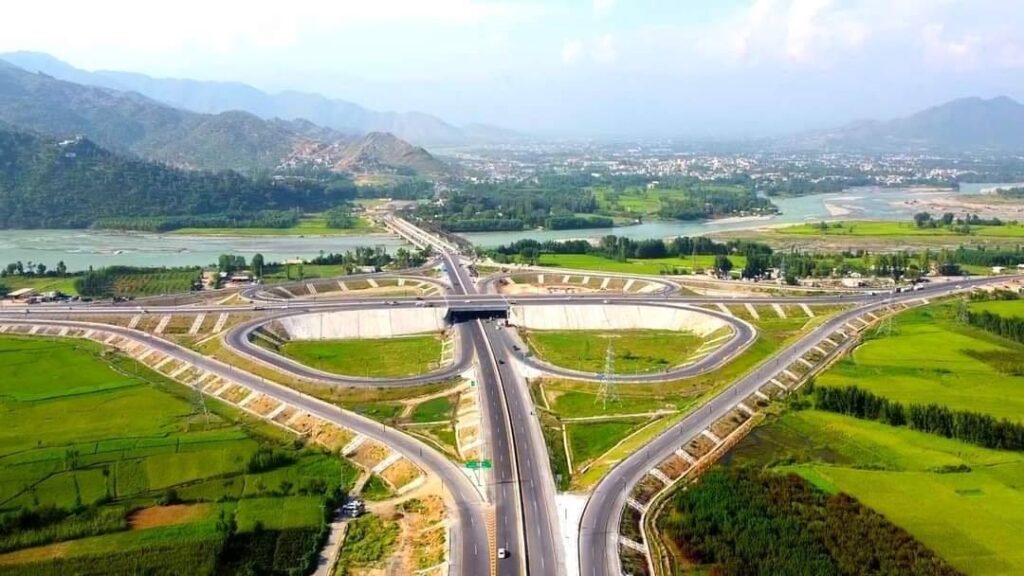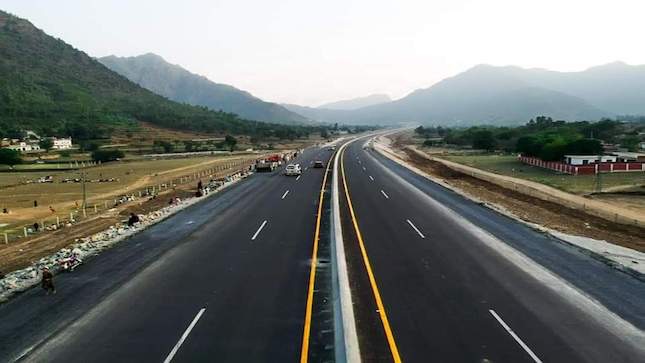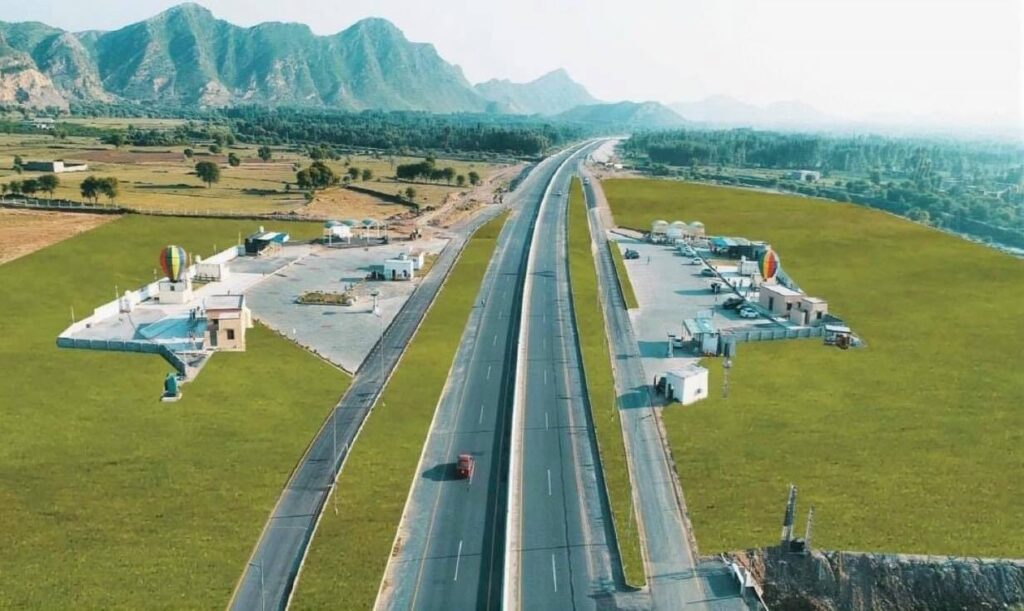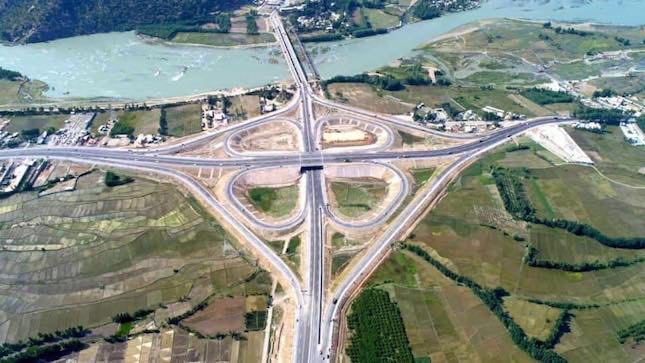Swat Motorway (M16) also called Swat Expressway is a high-speed route of approximately 160 km (90 Miles). Swat Motorway starts from Kernal Sher Khan Interchange on M1 Motorway and terminates in the vicinity of the Chakdara bridge on National Highway N-45 at the far south of Swat.
This recent addition to the Swat Valley road infrastructure is, in fact, a dual carriageway which officially is now referred to as Swat Expressway.
Table of Contents
- 1 Interchanges / Junctions on Swat Expressway
- 2 Swat Motorway Phase 1 Tunnels and Bridges
- 3 Swat Motorway Phase 2 Extension
- 4 Swat Motorway Speed Limit
- 5 Swat Motorway an Alternative Fast Route to Swat Valley
- 6 Reduction in Travel time from Swat to Islamabad
- 7 Benefits of Swat Motorway
- 8 How to Drive Safe on Swat Motorway?
- 9 Entering the Swat Motorway
- 10 Exiting the Swat Motorway
- 11 Lane discipline
- 12 Driving on the motorway at night
- 13 Stud colors and their meaning
- 14 Hard shoulder
- 15 Additional motorway driving tips
- 16 Is it really a Swat Motorway or Swat Expressway?
- 17 List of Other Motorways in Pakistan
- 18 List of Other Expressways in Pakistan
Interchanges / Junctions on Swat Expressway
There are a total of 7 interchanges / Junctions on the Swat Motorway. The south end of the Swat expressway starts from Nowshera and terminates at Chakdara in the north end which is the adjusted souther part of Swat.
Swat Motorway has seven interchanges starting from the Karnal Sher Khan Interchange to Dhobian, Ismaila, Bakshalay, Katlang, Palai, and Chakdara.
Swat Motorway Phase 1 Tunnels and Bridges
The Swat Motorway passing through 21 bridges and 1300 meters of twin tunnels near Swat Valley.
Swat Motorway Phase 2 Extension
Swat Motorway phase 2 is 80Km long extension project to the existing phase 1. Phase 2 of the Swat motorway is to link Chakdara Interchange to Fatehpur Madyan having 9 interchanges and 8 main bridges over the River Swat. The average distance amongst the interchanges in motorway phase 2 is approximately 10 Km. Interchanges planned for the project include Chakdara Interchange, Shamozai Interchange, Barikot Interchange, Takhtaband Interchange, Kanju Interchange, Malam Jabba Interchange, Sher Palam Interchange, Matta-Khwazkhela Interchange, and Madyan Interchange Fatehpur.
The total estimated cost of phase 2 of the project is Rs 60.5 billion, including the cost of Rs 20.5 billion for land & resettlement and construction cost of Rs 37.2 billion.
Swat Motorway Speed Limit
The speed limit on the Swat motorway varies. The max. speed limit on Motorway for Light Transport Vehicle (LTV) such as motor cars is 120 km/h (74.5 mph). The max. speed limit on a motorway for Heavy Transport Vehicle (HTV) and Public Service Vehicle (PSV) is 110 km/h (68.3 mph). On the highway, dual carriageway, and expressway whether in Swat or elsewhere in Pakistan the max. the speed limit for LTV/motor cars is 100 km/h (62 mph) and HTV is 90 km/h (56 mph).
Despite these standard maxes. speed limits, the max speed limit on Swat way varies as per weather, traffic, and road conditions and you must follow the speed limit displayed at the time of your travel.
If you drive above the speed limit, you are speeding. If you drive at a speed that is too fast for the weather, road, and/or traffic conditions, even if the posted speed limit is not exceeded- you are speeding. Speeding one of the most commonly reported factors associated with crashes, yet, few drivers view speeding as an immediate risk to their personal safety.
Speeding is the single biggest factor involved in road crashes. It increases the likelihood of a crash occurring and increases the level of injury/seriousness of the injury.
Swat Motorway an Alternative Fast Route to Swat Valley
The Swat Motorway provides highway speed, an alternate route for District Swat, Upper and Lower Dir, Chitral, and other remote areas within the Malakand and Bajour Agency promoting interconnectivity with developed regions of the country.
Swat Expressway has greatly reduced congestions and road accidents on the existing National Highway N-45 that passes through built-up towns of Rashakai, Mardan, Takhtbai, Shergah, Sakhakot, Dargai, and Batkhela.
Reduction in Travel time from Swat to Islamabad
The distance between swat and Islamabad is around 247 Km (153 Miles) which thanks to swiftly Swat Motorway has reduced the traveling to roughly 3 hours.
Benefits of Swat Motorway
The people of Malakand, Dir Upper, Dir Lower, Chitral, Shangla, Mardan and Swat districts would largely benefit from Swat Motorway.
Tourism being the main sector of attention of the Govt has been immensely promoted in Swat Valley and other parts of the Malakand division after the construction of Swat Motorway. The fruits, horticulture, agriculture, woolen sectors and other trade depending on the motorway transportation has upward boosted.
How to Drive Safe on Swat Motorway?
Due to the high speeds on motorways, when something does go wrong it can have serious and even life-threatening consequences. Therefore, it is a legal obligation to drive within limits and drive as safely as possible when on the swat motorway or elsewhere to avoid road accidents and any unforeseen circumstances.
Entering the Swat Motorway
As you move from the slip road towards the motorway itself, use your right indicator to make it clear to other road users that you intend to merge with motorway traffic. Try to match your speed with that of the left-hand lane traffic, then identify a suitable gap before merging.
It’s very important that you do not slow down dramatically or come to a halt as you approach the end of the slip road. Such behavior can be dangerous – not to mention frustrating for other road users.
Exiting the Swat Motorway
Be sure you are in the left lane in good time before you depart from the motorway. There are 100-yard markers leading up to every exit; you should switch on your left indicator by the 300-yard marker – if not before. Try not to decelerate while still on the motorway; reduce your speed on the slip road instead. This is safer and will not cause other road users to slow down unnecessarily.
Some slip roads may have two or more lanes. Be sure you are in the correct lane for your intended destination.
Watch your speed as you enter the slip road. If you have been cruising at 120 km/h (74.5 mph) for a long period, you may not realize how fast you are going once you reach slower roads off the motorway.
Lane discipline
The left-hand lane is for traveling in. The middle and right-hand lanes are for overtaking only. You should not stay in the middle or right-hand lanes any longer than necessary. Hogging the middle lane is now an offense and can be extremely unsafe – not to mention annoying for other road users.
In rare cases, it may be safer to stay in the middle or right-hand lane. For example, you may need to overtake a number of slow-moving vehicles, in which case it might not make sense to move into the left lane then back out to the middle lane on numerous occasions. Pass the slow-moving vehicles, then move back into the left lane when it is safe to do so.
Driving on the motorway at night
Some drivers feel night-time motorway driving is easier, largely because there is a lot less traffic than during daylight hours. However, the Department for Transport states that while only 15% of driving miles are clocked up at night, nearly a third of road injuries and deaths occur in this period. As such, night-time motorway driving deserves special attention.
Stud colors and their meaning
The road ahead will be marked out by various coloured, reflective studs. Use these to understand your position on the motorway at all times.
Red – Hard shoulder division
Amber – Central reservation division
White – Mid-lane division
Green – Slip road division
Hard shoulder
The hard shoulder is designed for emergency service access and as a place for broken down vehicles to park up safely out of the flow of traffic. You should not use the hard shoulder unless you have broken down, the motorway’s Active traffic Management System permits it (i.e. it is indicated on overhead gantries), or police/Highways Agency personnel tell you to do so.
On some motorways, when traffic volumes are high, traffic may be permitted to use the hard should as a normal lane.
Additional motorway driving tips
Keep your distance. In normal conditions, leave at least two seconds between you and the vehicle ahead so you have time to stop should the need arise. In wet or icy conditions, this period should be extended. Aiming for a four-second gap is sensible.
Plan your route. Know the name of the junction you intend to exit through and its location.
Ensure your tires are pumped to the manufacturer’s recommended pressure and that your vehicle has sufficient oil and fuel.
Beware of left-hand drive lorries from overseas. These lorries have right-hand passenger seat blind spots, meaning they can fail to see other road users in lanes they move into. It’s a good idea to stay well behind foreign lorries. This extra distance will also make it easier to overtake such vehicles because you will be able to see more of the road ahead.
If you have recently passed your test and do not feel confident using the motorway, ask an experienced driver to accompany you.
Is it really a Swat Motorway or Swat Expressway?
As nouns the difference between motorway and expressway is that motorway is (British, Ireland, New Zealand, parts of Australia) a broad highway designed for high-speed traffic, having restrictions on the vehicle types permitted and merging lanes instead of cross-traffic; in parts of the United States and other places called freeway while expressway is a divided highway where intersections and direct access to adjacent properties have been eliminated.
List of Other Motorways in Pakistan
| Name | Route | Length |
| Motorway M-1 | From Peshawar to Islamabad | 155 Km |
| Motorway M-2 | From Lahore to Islamabad | 334 Km |
| Motorway M-3 | From Lahore to Abdul Hakeem | 230 Km |
| Motorway M-4 | From Pindi Bhattian to Multan | 309 Km |
| Motorway M-5 | From Multan to Sukkur | 392 Km |
| Motorway M-6 | From Sukkur to Hyderabad | 296 Km |
| Motorway M-7 | From Dadu to Hub | 270 Km |
| Motorway M-8 | From Ratodero to Gwadar | 892 Km |
| Motorway M-9 | From Hyderabad to Karachi | 136 Km |
| Motorway M-10 | Karachi Northern Bypass | 57 Km |
| Motorway M-11 | From Sialkot to Lahore | 103 Km |
| Motorway M-14 | From Hakla to D.I. Khan | 280 Km |
| Motorway M-15 | From Hasan Abdal to Thakot | 180 Km |
| Motorway M-16 | Swat Motorway – Swat Expressway | 160 Km |
List of Other Expressways in Pakistan
| Name of Expressway | Length | Lanes |
| Peshawar Northern Bypass | 32 km | 4 |
| E1 Expressway | 65 km | 4 |
| Peshawar – Torkham Expressway | ||
| E3 Expressway | 100 km | 4 |
| Kot Sarwar–Hafizabad – Wazirabad Expressway | ||
| E5 Expressway | 103 km | 4 |
| Khanewal – Lodhran Expressway | ||
| E6 Expressway | 69 km | 4 |
| Sukkur – Jacobabad Expressway | ||
| E6B Expressway | 200 km | 4 |
| Ratodero-Sehwan Expressway | ||
| E75 Expressway | 130 km | 4 |
| Islamabad – Muzzafarabad Expressway | ||
| E90 Expressway | 66 km | 4 |
| Besham – Khwazakhela Expressway | ||
| Lahore – Nankana Sahib Expressway | 66 km | 4 |
| E2 Expressway | 28 km | 10 |





Swat Motorway phase 2 is infact the game changer specially the development of upper swat. Phase 2 will not only help the people of upper swat but will also boost the torurismum industory. The existing road from Mingora to upper swat is also not too bad but with phase 2 extention, the road journey will become more mother and will save alot of journey time.
Recently I had a great experience of driving on the swat motorway. In fact, this was the first time that I drove on this motorway and used it as an alternative to the legacy N45 route. In the past, I have frequently used N45 between Swat and Islamabad and also between Swat and Peshawar but my new experience was quite exciting. Despite several times refurbishment and widening works on N45, the comfort of travel on swat motorway far exceeds the legacy route. In comparison to N45, the Swat motorway at the south starts at Karnal Sher Khan Interchange which is a reasonable distance for traffic coming from both Islamabad and Peshawar. The most important factor that I couldn’t see on Google Maps is that sightseeing on either side of the Swat Motory is very attractive which makes the entire travel experience eventful. I certainly would recommend traveling on the Swat motorway as opposed to the old N45.
I recently had a great travel experience on swat motorway. The road itself is very safe and comfortable for driving both day and night. The signs and instructions on the road are clear and there is hardly any obstruction or barrier that can interpret your smooth ride. Services on swat motorway have all those amenities and facilities such as restrooms, public toilets, cafes & restaurants, petrol stations, etc. Having said so, the swat motorway is relatively new and with the passage of time the motorway services will improve to cater both the tourists and locals traveling on it.
The extension of Swat motorway phase 2 is an excellent project and will be beneficial for both locals and tourists. When phase 2 of the motorway is extended to the upper swat regions, it will reduce the travel time to Kalam, Malam Jabba ski resort, and other tourist destinations in Swat. Eventually, Swat motorway phase 2 will be linked with the upper dir and Chitral which link both areas for tourism and business activities.